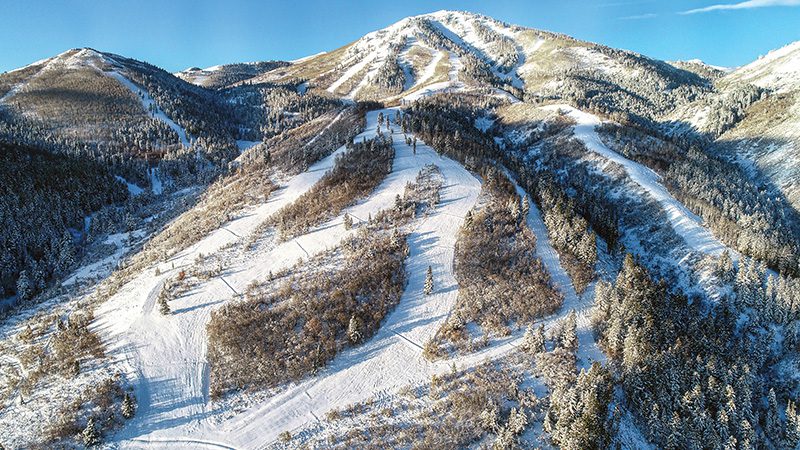Even in four-wheel drive, the worn all-season tires on my truck struggled for traction. A wet, heavy snowstorm, the first of the season, had plagued the drive for 230 miles since heading up Douglas Pass along Colorado State Highway 139. Finally, approaching Park City on US-40, the sun shone through a fleeting break in the clouds. Out the driver’s side window, was the future site of Mayflower Mountain Resort, and also the first place bare ground without a fresh blanket of snow was visible in roughly four hours.
The cruel bit of ironic coincidence was difficult to ignore. We’d awoken in a tent to a desert snowstorm and had been treated to Ullr’s early gifts right up to the moment we were passing a place that requires snow for its very existence. The dearth of snow, a trivial occurrence with a sample size of one, nevertheless echoed the degree of public skepticism about the resort’s location and future viability. The past couple of seasons, at least, lackluster snowfall had left the east-facing, lower-elevation terrain across from the Jordanelle Reservoir with nary a trace of snow cover, sowing a hint of doubt.
Turns out ski resorts don’t open or close based on ill-informed opinions, so Mayflower is slated to spin its lifts starting in 2024/25, and stakeholders feel they’re on track despite alarming recent snow trends and the lack of a confirmed operator. “We were very successful this past construction season, with mostly dry conditions to work on a variety of projects, underground infrastructure, and also obvious vertical projects and numerous ski runs,” says Brooke Hontz, Vice President of Development at Extell Development Company, which is developing Mayflower Mountain Resort. “We’re in continued conversations with Alterra, Deer Valley’s parent company, to be the resort’s operator, and we look forward to finalizing those conversations in a positive way.”
If no deal is struck with Alterra, Mayflower Mountain Resort will be able to operate independently with 4,300 skiable acres of terrain, 3,200 feet of vertical drop and ultimately 15 ski lifts.

There’s money to be made from ski resorts, so the inertia of capitalism will likely sort out the operator status. The more pressing and less solvable issue is whether there’s going to be adequate snow, especially at the base elevation of 6,575 feet.
“Certainly, snowfall is a concern, as it should be for everyone in the ski industry. But we can’t have a kneejerk reaction to what we hope are outlier years the past couple of seasons,” Hontz says. “We have 900-acre feet of water currently set aside for a state-of-the-art, automated snowmaking system. We’re looking at having an exceptional operator who can forecast and help us make snow that’s wonderful quality, just as Deer Valley has been able to do during the past couple of challenging winters.”
Snowmaking serving as the backbone of future ski resort viability isn’t unique to Mayflower, but without certain weather conditions, even that becomes challenging. “The Wasatch Back as a whole experiences some shadowing, which results in less precipitation, and the orographic effects tend to be less favorable as you move south from Deer Valley,” says Mike Wessler, a meteorologist with the National Weather Service in Salt Lake City. Mayflower indeed sits south of Deer Valley, but Wessler is quick to point out how such general rules are difficult to apply.
“Mountain meteorology is a fickle beast, and unique terrain orientation can have a significant effect on snow totals. We can only get reliable data from stations with long-term established data sets, and along the Wasatch Back that’s from Thaynes Canyon, downtown Park City and the Snake Creek Hydroelectric Power Plant,” he says. “Without that, historical snow conditions are difficult to pinpoint and future conditions are difficult to forecast.”
We may not be able to glean a lot about how much natural snowfall will grace Mayflower Mountain Resort, but we can gain some insight into snowmaking potential. “The Wasatch Back is particularly cold. It features these narrow valleys with poor drainage that traps air into cold pools. The minimum temperatures typically recorded at Snake Creek at 6,010 feet are comparable to what you see in Thaynes Canyon at 9,230 feet,” Wessler explains.
Those cold temperatures are what Mayflower Mountain Resort is banking on to make snow. Wessler noted across the west we’re seeing rising snow lines during storms while pointing out broad regional trends can’t be applied to something so specific as snowfall in a particular location. Even amid climate uncertainty, one thing’s for certain. Mayflower development doesn’t appear to be slowing down anytime soon


